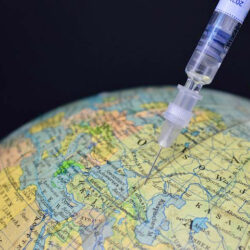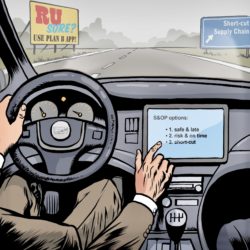Complex vaccination programme calls for connected planning

The recent Webinar Wednesday was all about the Netherlands’ vaccination programme: how do you get six different types of vaccines, each with its own characteristics and storage conditions, into 17 million arms as quickly as possible? And how do you ensure that the many hundreds of stakeholders involved in this project all have the same information? Three speakers provided the answers in the webinar organized by Supply Chain Media.
By Mirjam Hulsebos
Jan Fransoo is Professor of Operations & Logistics Management at Tilburg University and TU/Eindhoven. Like everyone with any understanding of logistics, he realized that the initiators of the Dutch vaccination programme – the Ministry of Health, Welfare and Sport, the National Institute for Public Health and the Environment (RIVM) and the 25 independent municipal health services (GGDs) – had underestimated the task ahead of them. They thought that the country with one of the most efficient flu vaccination programmes in the world could use the same infrastructure for the COVID-19 vaccinations. In reality, however, it was a whole new ball game in various respects, with different prerequisites, different restrictions and different business rules.
Back in January, as many as 300 people a day were contacting the Dutch Ministry of Health, Welfare and Sport to offer their services. One of them was Jan Fransoo. The difference was that he was part of a group of supply chain professionals and lean experts offering their services on a pro bono basis. More importantly, they had no vested interest in the healthcare industry. Besides academics, the team includes people from ASML, Heineken and 15 other Dutch companies. Moreover, they have access to a large pool of students who can develop models. “We were accepted after just a 30-minute pitch,” stated Fransoo during the webinar. The group has been involved in the vaccination programme since the end of January.
Mass vaccination and a finely meshed network of locations
So what’s the scale of the challenge? Fransoo: “First of all, the situation varies from one country to another. The Netherlands receives its vaccine supplies from the EU, so we’re keeping pace with the other EU countries in terms of availability. But because each national healthcare system is different, each country will have to build its own supply chain.” The Netherlands has a decentralized system in which healthcare is a mix of public and private tasks. In this case, the RIVM is coordinating the vaccination programme, while 25 independent GGD organizations plus 5,000 general practitioners (GPs) are largely responsible for the implementation. In addition, hospitals and long-term care organizations have a role to play in vaccinating their own staff and residents. Although the RIVM and Ministry of Health, Welfare and Sport are organizing it all, there is no line of command.
A second challenge is that this programme is not a case of ‘either/or’; it requires both mass vaccination and a finely meshed network of vaccination locations close to citizens. Besides the mass vaccination locations operated by the GGDs and the finely meshed network provided by GPs, the supply chain must also be prepared for out-of-the-box solutions. Fransoo: “If analysis shows that young people are less willing to be vaccinated, for example, you might want to set up a vaccination location at a festival site. What would that require? How could you organize the logistics, register who has been vaccinated and arrange the follow-up vaccine if necessary?”
A product supply chain…
The market is currently dominated by scarcity. The vaccine supply chain has all the characteristics of a supply chain for new products: suppliers are not particularly reliable because the production capacity still has to get up to speed. Due to so many uncertainties, it is difficult to make delivery forecasts. The Netherlands has agreements in place with six vaccine producers, but each type of vaccine must be stored and transported under different conditions. For example, once it has reached refrigerated temperature the AstraZeneca vaccine has a much longer shelf life than the Pfizer or Moderna one. Meanwhile, no second shot is required of the Janssen vaccine, which is still currently in the process of being approved.
Besides all six vaccines requiring different storage conditions, another complicating factor is the fact that the instructions may change at a later stage. For example, the Pfizer vaccine originally had to be stored at -80 ⁰C and then kept for four days at refrigerated temperature. It has since been discovered that the vaccine can be stored at -25 ⁰C for two weeks before being thawed, similar to Moderna’s vaccine. Last but not least, the regulations are constantly changing too. For example, it turns out that different countries interpret the advice from the EMA and from manufacturers differently, which in turn leads to the rules being amended.
…plus a service supply chain
However, in addition to being a product supply chain it is also a service supply chain, according to Fransoo: “After all, you don’t just need a vaccine; you also need someone to administer it, and someone’s arm to inject it into. Those three things all have to come together in the same location at the same time. Capacity planning is therefore very critical. That’s why in the Netherlands we’re currently building a surplus of vaccinators so that we can cope with the demand at all times.” The Netherlands is also taking a cautious approach in order to maintain the general public’s confidence. “In Germany, for example, they now have AstraZeneca’s vaccines, the vaccination locations and the vaccinators, but no one wants that vaccine because its reputation has been tarnished.”
In other words, no matter how well organized the product supply chain is, it grinds to a halt without customers. Fransoo concluded: “Normally, you build your capacity based on a forecast. The problem now is that there is no reliable forecast – neither about when the vaccines will be delivered nor how many people will want the vaccine. All we have is a whole range of possible scenarios and a goal: to vaccinate everyone who wants it before 1 July. So it’s basically reverse S&OP.”
Connected planning
Automating S&OP is Anaplan’s specialty, which is why the vendor has developed a solution for the vaccination issue. During the webinar Ara Gopal, Head of Industry & Partner Solutions, agreed that the complexity is enormous. “You have to deal with a lot of data flows, business rules and constraints, plus they are constantly changing. Moreover, they are different in every country. To make things even more complex, the large number of stakeholders must find common ground and then make decisions based on the same data. In addition to supply chain challenges, they have to deal with many more issues such as how to reach all the population groups, how many call-centre employees to deploy, and how to avoid negative publicity.”
Another factor is the lack of time to implement a large enterprise tool. The solution must work right now and be so simple that all the parties involved can use it. Gopal: “Our goal is to eliminate the Excel sheets that are currently being used. We want everyone to be able to work with the same set of data based on a unified data model.” The solution Anaplan developed has already gone live in one US state. “It covers everything related to vaccine distribution. We have connections to all data supply systems, plus people can upload their own Excel files. As a result, everyone has access to the same data, so that better decisions can be made more quickly,” said Gopal.
Cloud-based tool
Tata Consultancy Services has been hired by several governments to provide consulting services and was therefore involved in setting up the system. “There is a huge need for a cloud-based connected planning tool at the moment,” stated Muralidharan Murugesan, Global Head of Strategic Solutions at Tata. That would enable multiple parties to log in easily from any location. “What’s needed is a tool in which you can bring all the data together, calculate scenarios and make forecasts. Moreover, it must be an agile platform that you can easily roll out because, as Ara Gopal already said, there’s no time for a lengthy implementation process.”
Lastly, according to Murugesan, a very robust system is needed that can handle the scale required. “Because globally we’re talking about five billion people who need to receive a vaccine, spread across 219 countries. You need two shots of most vaccines and a lot of waste occurs due to the strict storage conditions, so we estimate that 12 billion doses will be needed worldwide. Because of the scarcity, the current goal is to administer 27 million vaccines per day, and that vaccination rate should ideally be increased as soon as the production capacity allows it.”
A handful of states in the US and also several countries are now introducing Anaplan’s solution. This is a major step forward, according to Murugesan. “Especially because we can now link everything: location planning, distribution planning, resource planning and expense planning. You can immediately see the consequences of a certain decision, so you can prepare better. This is going to help reduce waste and speed up the vaccination rate.”










